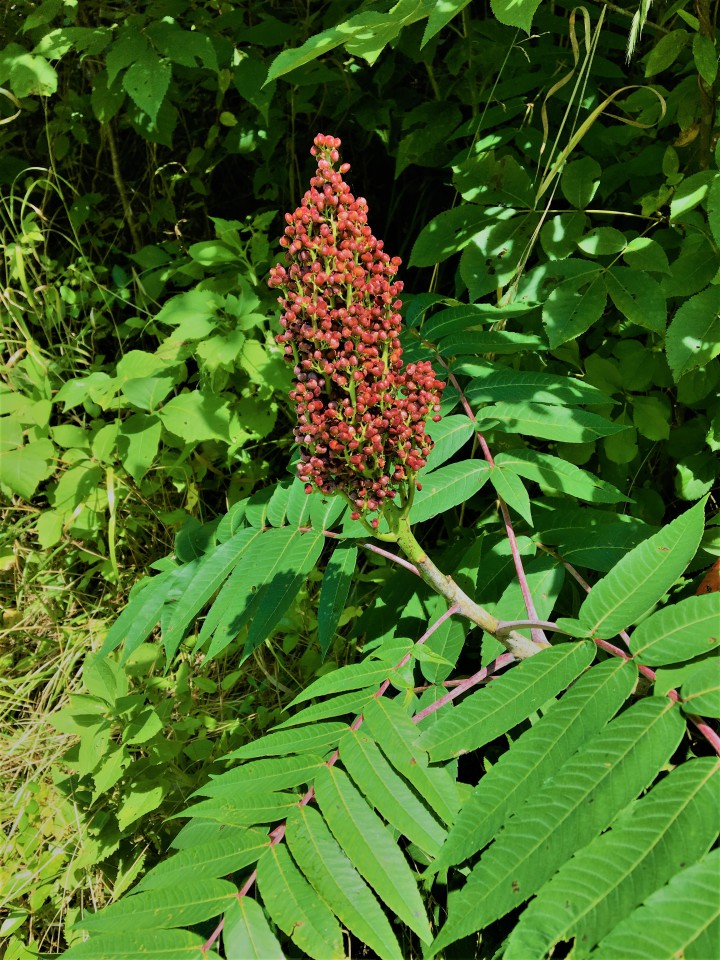A beautiful arrangement of dark red, dried sumac berries greets me every morning as I walk into my kitchen. Harvested almost two years ago from a roadside in Madison County, these pungent berries still have loads of flavor.
The clusters form atop small to medium-sized trees lining highways and byways all over our region. As a matter of fact, the sumac tree is native to our state as well as every other state in the continental U.S., according to the University of Texas Plant Database.
This time of year, local foragers don’t have to travel too far when looking for the fuzzy berries, which are used as a spice in Middle Eastern culinary traditions and, increasingly, in local cuisine. “It’s not something you’d go deep into Pisgah to look for, necessarily,” explains Noah Poulos, a local environmental scientist, arborist and invasive-plant management technician. “It thrives more along edges of forest and grassy or disturbed areas. I see it a lot in parking lots, going to trails, on the margins.”
Poulos, who earned a bachelor’s degree in environmental science from UNC Asheville and has had special training in botany and plant identification. stresses that poison sumac is a completely different plant. While the edible sumac berries grow on trees, poison sumac does not have red berries, is more of a ground cover and is not common in our area.
Forager and Asheville Wild Foods owner Ryan Milt uses sumac berries to make an Appalachian version of the popular Middle Eastern spice mix za’atar. To complement the flavor of the sumac, which he describes as tart and citrusy, he adds a wild bee balm in place of the traditional oregano.

Milt says there are three different varieties of edible sumac that grow in our region. “The most used is smooth sumac — it’s got a nice, tart cranberrylike flavor,” he says. “Winged sumac has a flavor more like rose hips, and staghorn sumac is kind of fuzzy; it doesn’t have as much flavor.”
Spicewalla, a local spice company owned by Meherwan Irani of Chai Pani fame, also sells a sumac-laced za’atar blend. Irani describes za’atar as a catch-all Middle Eastern seasoning. “It reminds me of garam masala in the sense that every version I’ve seen is unique. There is no one standard formula for it. Every family and every region in the Middle East has their own.”
Irani and his chef de cuisine, James Grogan, both love the flavor of sumac, and as a result, the Spicewalla za’atar blend contains a good amount of the intensely flavorful red powder.
Spicewalla imports its sumac powder from Turkey, and according to local ethnobiologist Marc Williams, it is not the same varietal growing so prolifically along our roadsides. But a side-by-side taste test with the red berries in my kitchen revealed a very similar flavor profile.
Sumac berries are easy to harvest from August through December by simply cutting them off the tree at the base of the cluster, but Poulos emphasizes using good tools so the tree is not damaged. He also encourages moderation. “Something to be mindful of with this and any other wild harvesting is making sure you are taking enough to serve you but also leaving some behind for other wild foragers and not stripping away all the sumac from one area,” he says.
Fresh sumac berries can be used right away to make a citrus-flavored tea. Milt recommends using cool or lukewarm water because hot water extracts tannic acid, which brings out a strong, bitter flavor. “If you put sumac in cold to lukewarm water in a Mason jar and shake it around, then you’re going to get a lot of flavor — it’s very water-soluble,” he explains.
The tea can be used in a number of ways. Irani recommends cocktails, using it just as you would lime juice or other acidic ingredients. “Every time I’ve had a drink with sumac in it, I really like that sort of acerbic effect on the tongue,” he says. “It’s more than just sour; it’s activating all those puckering agents in your mouth.”
As evidenced by the specimens in my kitchen, dried sumac berries will keep for a couple of years, and once dried they can be ground into a powder with a spice grinder. The berries do have a hard inner seed, but if your grinder is powerful enough, it will get pulverized along with the fruit. Another method involves rubbing dried berries in a fine mesh strainer, removing the dried fruit from the seed, and collecting the powdery pungent spice that falls through the mesh.
According to Irani and Grogan, one of the best applications for the dried spice is combining it with meats for kabobs or roast chicken. Meanwhile, Poulos enjoys mixing it with sweet spices like cinnamon and nutmeg for zucchini bread and pumpkin pie. Milt uses it in his pickle brine to decrease the pH and brighten the flavor.
Obviously, the uses for this flavorful native plant are numerous, and because sumac can be identified easily, it’s great for foragers of all skill levels. Plus it can double as a decorative arrangement in your kitchen until you’re ready to eat it.




original story and didn’t think sumac berries were commonplace in our Appalachia region. we import and make a zaatar mix and that uses sumac grown at the base of mount Hermon on Lebanese side. It’s lemony taste that you can also make lemonade from. It be interesting to taste the zaatar mix from Asheville Wild Foods with the local sumac.
also, on zaatar mixes, it’s true mix recipes vary, but note that qualities is a different story. most zaatar mixes on market has a lot of unknown fillings like wheat or ground straw (no kidding) and substitutes. for example, sumac is substituted with citric acid in cheap blends.
Elaine,
Tyme Foods
http://www.eatzaatar.com